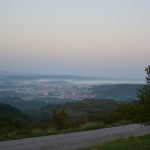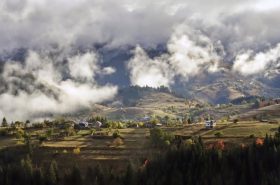Arbanassi is one of the remarkable sites around Turnovo. It has been known as a settlement since the 6th century by Justinian. It was the residence of the Roman aristocrats. During the Second Bulgarian State it was the summer residence of the Bulgarian kings and boyars. In the second half of the 15th, Slavs from the town of Moshopol (Northern Epirus, Greece) and the Albanian city of Berat (which was Bulgarian) moved here. In the early 15th century, the Turkish sultan presented her as a feudal mansion after the wedding with her daughter. After the 15th century, Arbanassi is a settlement that enjoys the privileges of low taxes. This contributed to the rapid enrichment of the settlement.
There are written monuments from the 1617s that testify to numerous attacks on Ottoman gangs. This is also what the architecture of 1617 c. Then the so-called houses fortresses were built. An example is the Konstanzaliyev house, dating from 1744, on the ground floor has 1.5 m thick walls, while the ground floor and the first floor had a 1m wide floor with timber renovation. Upstairs, most of the summer rooms were tiled to keep cool. There were guest rooms, living rooms, bedrooms, dining rooms, maternity room isolators. There, she only cared for her breast for up to 40 days and the man was not allowed to disturb her.
Unlike in central and western Europe, there were indoor toilets, male and female, since they sometimes had to live under siege. They used quicklime for hygiene. In addition, each room had lattice windows and thick metal-reinforced doors. Each room could thus be guarded individually. And the exterior windows had sliding shutters. As they made the fireplaces, a fireplace served two rooms, heated on either side of the wall.
- Photo credit: Iliana Teneva
- Photo: Brendan Cox
- Photo: Nikolai Karaneschev
- Photo credit: Iliana Teneva
The Church of the Nativity
The Church of the Nativity can be called the Sistine Chapel in the Balkans. It has over 3700 images and about 2200 scenes. The first room, the male one, was built in the 16c. In 1639 the women’s room was built westwards. To the north, they build a gallery that was originally opened and then built (17c). It served as a scriptorium (books were written there) and a refectory (dining room). There are two layers of murals 16c and 17c. In the men’s ward, the iconostasis was grafted after a fire at the end of the 18th century. It was taken from another church. The scene of the Last Judgment (on the outside of the male compartment and at the same time internal on the female) is preserved by 16c, and the upper layer of 17c is taken down and transferred to the NIM. The first turned out to be beautiful and valued as a cultural and historical heritage. The murals were refreshed in 1971 and the church was under the auspices of the Ministry of Culture. One of the emblematic murals on the roof has three images of Christ. The first is Christ Emmanuel, who is the 12 year old Christ. The middle one is Christ Pantocrator, again in a locket. The latter is the Fatherhood, taken as a motive by the Roman Church. The Holy Trinity is depicted here, but in a line, not a triangle. God the Father holds Christ on his knees and mourns for Him. We have the same scene in Alexander Nevsky’s dome.
The women’s ward, and not only known by the Last Judgment, but also by a huge panel with the genealogy of Christ (the genesis of Christ). At its base (north), instead of starting with the 12 apostles, there are 12 philosophers painted with parchment in their hands. This is because in the 17th century Bulgarian intellectual ecclesiastical circles were of the opinion that Greek philosophy was at the heart of the blood. A little later, from 1643 there is another similar panel in the Bachkovo mr. There is an inscription on the front door with the donors and the date of creation of the women’s ward. The following is the Scriptorium, a small chapel divided into male and female wards and painted with the life of John the Baptist. There is a hidden dome technique on the outside. The roof of the church is like a house, and the inside is a dome. This is because wherever there is a dome, beneath it is the heavenly kingdom of Christ. The Eternal Calendar (with the Feast of the Saints), the Ecumenical Councils and others are also painted.
- Photo credit: Dennis Jarvis
- Photo: wikipedia / Zlatimir23
- Photo: Jerry Michalski
- Photo: wikipedia / yeowatzup
The Church of the Holy Archangels
The Church of the Holy Archangels has a gallery, separate female and male wards. It was built in the middle of the 17th c. There are mostly female topics in the women’s ward. It served for some time as a narthex (narthex, vestibule) before being made a female ward. There is an inscription with the names of the master painters. “From the hand of Michael of Thessaloniki and George of Bucharest under the supervision of Eustatius H. Nicholas, 176061, August 11.” Here we have a greater pursuit of idealism with idealized and aesthetically subtle features of persons. The iconostasis is mostly masters of the Tryavna painting school. Some of the better known are Daskal Krustyo, Zoyo. Wood carvers from Tryavna also participated. In the men’s ward there is a hidden cross-domed church, two hemispheres with seating (conchas) forming a cross with the main part of the church. There are pendants that depict the four evangelists.




















